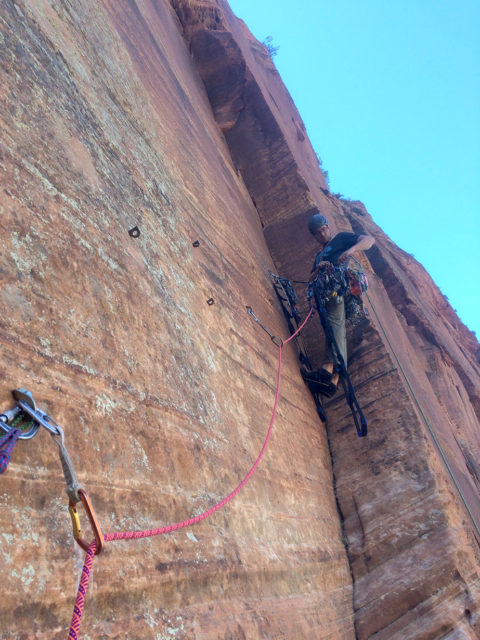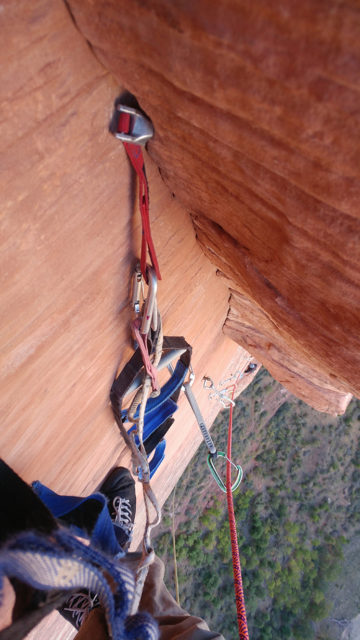
2018 Sterling Evolution Helix Rope
Sterling Evolution Helix
Diameter (mm): 9.5
Rope Type: Single
Sheath (%): 41
Weight (g/m): 59
Dynamic Elongation (%): 31.9
Static Elongation (%): 7.2
Impact Force (kN): 8.9
UIAA Falls: 7
Available Lengths (m): 40, 50, 60, 70, 80m (DryXP available in 60, 70, 80m)
Bicolor Available: Yes
Length Tested: 70m non-bicolor
MSRP: $279.95 (70m, non-bi color)
Days Tested: 9
Test Locations: Rocky Mountain National Park, Clear Creek Canyon, Eldorado Canyon, & Independence pass, CO; Zion NP, UT
Intro
This past season, Sterling introduced an interesting new dry treatment they call “DryXP.” Matt Zia recently reviewed the DryXP-treated Fusion NanoIX, which is a lightweight 9.0 mm rope. Meanwhile, I’ve been testing the DryXP treatment on Sterling’s Evolution Helix, a 9.5 mm do-it-all rope. While neither the Helix nor NanoIX are new ropes in Sterling’s line, the treatment itself is new, and we wanted to see (1) how well it performed and (2) if it brought any unwanted changes to the performance or handling of these two ropes that we really like. So, this review will focus principally on the dry treatment and how it affects the Helix. It’s worth noting that both the Helix and NanoIX are available without the DryXP treatment, and if you’re looking to get a sense of the Helix’s performance in general, check out our review from a couple years back.
It is also important to mention that I ended up putting a core shot in this rope after about a dozen uses. It was a pilot-error scenario while on Prodigal Sun in Zion (thankfully almost at the top of the route…), and I’ll discuss this further down. While this wasn’t the fault of the Helix, it did prevent me from doing any long-term durability testing on the treatment.
Construction and Specs
The Helix is 9.5 mm in diameter, which places it near the middle of the pack among single ropes. The 59 g/m weight of the rope is relatively light for ropes of that diameter — this is almost the exact same weight as Mammut’s Infiinity, and less than the 62 g/m weight of Edelrid’s Eagle Light Pro. Though, if a few grams in weight difference is a chief concern, I think you’d be much better off checking out a narrower rope than you would be if simply choosing the lightest rope in the ~9.5 mm category.
The sheath material of the Helix constitutes 41% of its total weight. This percentage is on the high end, relatively speaking, though many manufacturers don’t publish these figures. This ratio is even at the high end among single lines in Sterling’s own line. More sheath (or less, for that matter) isn’t necessarily a better thing, but it does signal what the rope is best equipped to tolerate. What I mean by that is, climbing ropes consist of two major parts: the core and the sheath. (This construction is what is being described if you’ve ever heard a rope categorized as a “kernmantle” rope; “kern” refers to the core while “mantle” refers to the sheath)

The core of the rope bears most of the forces of catching a fall, while the sheath is meant to protect the core from wear and abrasion, but only contributes to a minority of the stopping effort when you fall. Consequently, the question of how much sheath material to use relative to the core really comes down to what you most need protection against.
For sport climbers on overhanging projects where the rope isn’t actually running over the rock all that much due to the steep angle of the climb, you might not need quite as much abrasion resistance. Meanwhile, a climber who plans to bring their rope up vertical to less-than-vertical terrain (e.g. big walls or alpine routes) will probably benefit more from having a more abrasion resistant rope to deal with being run over / across the rock.
What does this mean for the Helix? Well, at 41% sheath material, we’re firmly in the “abrasion resistance is important” category. On the other hand, the 9.5 mm diameter and really smooth hand (more on that later, and much more on that in the previous Helix review) make it more than simply a good work-horse rope for low angle climbing or long top-rope sessions. The combination of lots of sheath material, a thinner diameter, and excellent handling means that the Helix is a good fit for those looking for a do-it-all rope, one which will go with you to your local project or a few alpine objectives while also enduring top rope sessions at the crag week after week.
DryXP Treatment
DryXP is not any one material but rather a group of things Sterling does to a rope to pass the UIAA “Water Repellent” test for dynamic ropes. This certification is only a few years old (introduced in 2014), but it brings a welcome degree of standardization to the way ropes are treated for moisture. According to the UIAA press release on the certification, untreated ropes can absorb as much as 50% of their weight in water. Insufficiently treated ropes vary wildly, frequently ranging from 20%-40% water absorption by weight, but are still able to be sold as “dry.” For the UIAA certification, however, the rope must absorb less than 5% of its weight in water.
I spent some time as a materials scientist and engineer with a bunch of exposure to different coatings and processes, so I was curious to get more details on the DryXP process. For more info, I spoke with Chuck Weber, Sterling’s Process Manager, over email and he broke the whole thing down, which I’ll paraphrase here.
Fundamentally, “DryXP” consists of the standard “DryCore” treatment that Sterling applies to the cores of all their dynamic lines. This isn’t enough to get down to 5% water absorption, so the sheath undergoes its own process of coating followed by a curing stage (basically a low-temperature annealing) used to “set” the material. Chuck explained to me that sheath treatments are more difficult than core treatments because they encounter all sorts of other things, such as dyes, which can react with a potential dry treatment and cause it to fail or lose efficacy (sheath fibers are typically un-colored, plain Nylon which are later dyed). This means that finding a good sheath treatment (both material and curing protocol) is difficult as far as the chemistry is concerned.
So why does this matter? Well, a rope that absorbs a lot of water can be a pain due to the extra weight you’re now carrying around, but it can also be a safety concern. Saturating the threads with a lot of water can adversely affect the way the rope handles, it can reduce the forces the rope is capable of tolerating (this is similar to porous sandstone after it rains), and it can cause the rope to freeze up if you’re out in the winter.
DryXP Performance
I was only able to get a handful days in where I could get a sense of the treatment’s performance — one on some early-season ice in Rocky Mountain National Park, and another during a rainy day at the crag before I took the Helix to Zion and got a decent core shot while climbing Prodigal Sun in Zion (more on that further down).
During the two days I attempted to soak the rope, it was remarkably dry at every belay and at the end of the day when I was coiling it. From my experience, the DryXP is at least as effective as every other treatment I’ve ever used. Matt Zia and I both think very highly of Beal’s Golden Dry treatment, and the highest compliment I can pay the DryXP is that it would be very hard to tell the difference between the two in the field.
One thing I didn’t love about the DryXP treatment was that it has a slightly tacky feel, though it didn’t really affect the rope moving through a belay device and therefore never graduated beyond a minor offense. Otherwise, I didn’t notice any difference between this version of the Helix and the previous generation, which was a relief.
Durability
As I noted above, I ended up putting a core shot in the Helix while climbing Prodigal Son in Zion. The last “pitch” of that route is a low angle scramble up a loose, sandy gully and we had hauled our gear up so that we could spend the night on the wall (something that had been on my partner’s bucket list, otherwise this route is much better in a day).

In a rush to top out and get to some hot food and a beer, I ran up the gulley, built an anchor and fixed the lead line, only then realizing that in my haste I’d left the haul line. Since I’d already fixed the lead line, I threw a gri gri on the line and started basically hopping down the gulley as fast as I could to retrieve the other rope. I tried to negotiate a lip of sandstone by running backwards (still on the gri gri, mind you) rather than carefully picking my way down the mini wall. As a result, I slipped and slid off to one side, running the rope along the edge of the wall, cutting the sheath in the proces.
The core shot was firmly my fault, and was the result of cutting corners at the end of a long day, but I still ended up having to cut the rope in half. Bummer to lose a rope so early but hey, now I’ve got a nifty 35 m glacier cord.
Due to it’s high sheath percentage, I’d expect good durability from the Helix as long as you don’t put it through any excessively abrasive falls like I did.
Bottom Line
The Sterling Evolution Helix has, for some time, been a great high-end rope for all-purpose use. It’s not the cheapest rope out there, so you’ve got to be willing to pay for the smooth feel and easy handling that comes with that price tag, but it’s also built to last for multiple seasons (just don’t forget the haul line at the last belay and slice your rope by tripping sideways while running over an edge as you hastily descend to retrieve it).
As far as the DryXP treatment goes, it’s proven to be a very effective coating by the numbers, and in the field. The coating does have a barely perceptible tacky feeling that is a bit odd, but it doesn’t really impact the way the rope handles. Beyond this quirk, however, the DryXP treatment elevates an already great single rope by keeping the rope bone-dry in wet conditions and thus running smoothly through carabiners and belay devices. So, if you’re looking for an all-around rope that handles very well and has excellent water resistance, the Sterling Evolution Helix is certainly worth a look.
